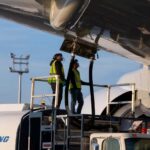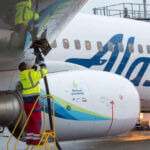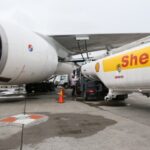Global airline body IATA has called for “urgent action” on better understanding of the climate effects of non-CO2 emissions from aircraft at high altitudes, in particular cirrus cloud formation from persistent contrails. Scientists have long warned that contrails have a significant net warming impact on the climate but a new report by IATA says significant knowledge gaps remain in the complexity of contrail science and calls for more data and research. However, it is pushing against a move by the EU to introduce from January 2025 mandatory monitoring, reporting and verification (MRV) of non-CO2 emissions from all flights departing, arriving as well as within the European Economic Area (EEA). An alliance of European low-cost airlines – Ryanair, easyjet and Wizz Air – together with NGOs led by Transport & Environment have now written to urge the European Commission to resist IATA’s lobbying to restrict the scope to intra-EEA flights.
All sides accept that aviation’s climate impact extends beyond CO2 emissions, with non-CO2 effects such as contrails and nitrogen oxides also contributing to global warming. However, with uncertainties over the scale of the problem and how to tackle it, action by industry and policymakers has so far been lacking, although that is beginning to change. A number of airlines are taking part in contrail avoidance trials, while others have installed monitoring equipment on their aircraft. The EU, on the other hand, now wants access to extensive non-CO2 emissions data from flights before implementing a policy decision that could eventually result in airlines paying for their non-CO2 as well as CO2 emissions under the EU Emissions Trading System (EU ETS). The UK government has indicated it intends to carry out a policy consultation on the non-CO2 issue sometime this year.
Following its newly-released report ‘Aviation Contrails Climate Effect: Tackling Uncertainties & Enabling Solutions’, IATA is calling for “a strengthening of collaboration between research and technological innovation, coupled with policy frameworks to address aviation’s non-CO2 emissions through more atmospheric data.” The lack of high-resolution, real-time data on atmospheric conditions – particularly humidity and temperature at cruising altitudes – hinders precise contrail forecasting, argues the report.
“The industry and its stakeholders are working to address the impact of non-CO2 emissions on climate change, particularly contrails,” said IATA’s Director General, Willie Walsh. “To ensure that this effort is effective and without adverse effects, we must better understand how and where contrails form, and shrink the uncertainties related to their climate impact.”
This requires more trials, collection of more data and improvement of climate models, alongside developing mature technologies and operations, he said.
“Formulating and implementing regulations based on insufficient data and limited scientific understanding is foolish and could lead to adverse impacts on the climate,” he warned. “That is why the most important conclusion from this report is to urge all stakeholders to work together to resolve current gaps in the science so that we can take effective actions.”
The study, conducted with a number of industry organisations and research institutions, recommends a course of action over the period to 2050. In the immediate term, until 2030, the priority should be on mitigating CO2 emissions, while increasing airline participating in sensor programmes, continuing scientific research and improving humidity and climate models for the purposes of contrail mitigation, it says. In the mid-term (2030-2040), action should be taken for data transmission, continuous validation of models and encouraging aircraft manufacturers to include provisions for meteorological observations, as well as selected avoidance.
Over the longer term (2040-2050), the report expects aircraft to be continuously supplying data, with models and infrastructure in place to provide reliable results. By then, there should also be a more complete understanding of the non-CO2 effects from alternative fuels, it forecasts.
“These action items collectively aim to mitigate the climate impact of aviation while advancing scientific understanding and technological capabilities,” it says.
However, IATA is dismissive of the EU’s plans to collect non-CO2 data from flights as of next January and for the European Commission to come up with a legislative proposal by the beginning of 2028 to expand the scope of the EU ETS to include non-CO2 aviation effects.
The proposal could serve as “a first-stage experiment that attempts to achieve a baseline estimation of the non-CO2 effects of aviation,” says IATA. “However, it is currently not feasible to validate the output from the experiment to ensure that it accurately represents reality.
“Studies have shown that estimating the formation of individual contrails using past weather and trajectory data could lead to incorrect results 50-80% of the time. An MRV system for non-CO2 emissions today could support further research thanks to additional data but the science is not mature enough to allow confidence in its implementation at a policy level.
“It is conceivable that by attempting to avoid the formation of contrails and reduce reported non-CO2 emissions, operators could inadvertently increase their CO2 emissions. The complex and likely trade-offs amongst different non-CO2 emissions, and between these and CO2 emissions are still poorly understood.
“Considering all the challenges and uncertainties, introducing an MRV system as early as January 2025 would not serve to mitigate aviation’s non-CO2 effects under the EU ETS.”
The decision to include non-CO2 MRV was agreed by the European Parliament and member states last year and incorporated as an amendment to the EU ETS Directive 2003/87/EC. While MRV under the EU ETS in respect of CO2 emissions is restricted to intra-EEA flights, the new non-CO2 rule also applies to all flights that depart or arrive at an EEA airport.
IATA recommends airline participation in the MRV framework should be voluntary, given its “experimental nature”, and its application scope should be “strictly intra-EU” to mirror that for CO2.
“Any intention to expand beyond the current EU ETS application scope for aviation would imply a legal risk of extraterritorial impact and would work counter to any MRV implementation,” it argues. “Furthermore, the probability of contrail formation is highly dependent on the region: mid-latitudes have a higher probability of contrail formation than the tropics or the equator, so contrails affect different regions differently.”
However, a policy paper by European NGO Transport & Environment (T&E) responds that full geographic scope is essential to ensure the credibility of the scheme. “It allows a better understanding of the impacts of long-haul flights, which research shows to cause more warming and present more promising mitigation opportunity,” it says. “A reduction in the scope would significantly limit the amount of data and the opportunities to mitigate non-CO2 effects beyond intra-EEA flights.”
The paper notes that shipping companies are now required to monitor maritime non-CO2 emissions for voyages to, from and within the EU. “Aviation cannot seek another exemption while other sectors are required to do more.”
It adds: “As non-CO2 emissions account for two thirds of aviation’s climate impact and adversely affect human health, the aviation industry must no longer avoid its responsibility but instead take decisive action to confront its complete environmental impact. The MRV scheme is a necessary first step aimed at better understanding these effects with a view to explore mitigation pathways. Any divergence from the original full scope would only lead to a large part of aviation emissions remaining hidden from regulators and consumers alike.”
Commented T&E Aviation Policy Manager Krisztina Toth: “Non-CO2 emissions were recognised as a climate problem 25 years ago. A monitoring tool offers a much needed first step that will help bring more understanding of the full climate impact of aviation. But some legacy carriers are lobbying to weaken the proposal, using uncertainty as an excuse.”
Full scope alliances
T&E has formed an coalition on the issue with low-cost carrier easyJet, as well as industry actors and other NGOs to urge the Commission to maintain the full scope of the non-CO2 MRV.
In a letter to the director-generals responsible for climate and transport, as well as the climate minister for Belgium, which currently holds the EU presidency, the group said: “It is critical that the full geographic scope is retained, as it is the only scientifically sound basis to understand the impact of aircraft types and geographies, and allow a better understanding of the impacts of long-haul flights, which research shows to cause more warming and present larger mitigation opportunities. It is vital that activity in areas such as the North Atlantic region, with a high concentration of contrail formation, are monitored and understood.
“Given the volume of their contribution to this issue, any deviation to exclude long-haul routes from the scope would be a significant missed opportunity which would empty the MRV of most of its meaning from a climate impact mitigation perspective, and undermine the scientific basis for future action. It would also go against the original agreement between the co-legislators.”
In a separate letter to the two Commission director-generals, easyJet has teamed with rival low-cost carriers Ryanair and Wizz Air to present a similar joint position on maintaining the full scope of non-CO2 MRV. “We call on the Commission to reject IATA’s attempts to restrict monitoring of non-CO2 effects to intra-European flights,” they said in a statement.
“We do not understand the intent of this effort to undermine the MRV scheme and why significant parts of the industry do not want to further the understanding of the science of non-CO2 effects,” says the letter.
“The purpose of the scheme is to support the development of a robust scientific evidence base. There is currently simply too much uncertainty around non-CO2 effects to drive policy development or to even reach a coherent understanding of the impact of non-CO2 on warming. This is precisely why we need such a system and why it must not be limited to intra-EU flights.
“Without robust science, it will not be possible to develop a policy measure to address non-CO2 effects, so if the EU chooses to restrict the MRV it is by default choosing to remove the option of a future policy instrument.”
IATA’s concern over the extraterritorial application of the non-CO2 MRV to airlines from third countries arriving at and departing from EEA airports has justification. The EU ETS in its original scope was similar but it faced considerable international opposition from countries such as China, India, Russia and the United States. China threatened to withdraw a sizeable order of Airbus aircraft for one of its carriers. The US passed legislation, which is still in force, that provides powers to prohibit its airlines from complying with EU ETS regulations. In the face of such opposition, and with the expectation that ICAO would come up with a market-based global scheme to address carbon emissions from international flights (ICAO member states later agreed the CORSIA carbon offsetting scheme), the EU backed down and restricted the scope of the EU ETS to intra-EEA flights on a time-limited basis.
The letter from the three LCCs acknowledges “there are reasonable concerns” around the scale of MRV data required from airlines and third country airline involvement. However, they say: “We think these can be resolved through a pragmatic approach to the implementation of the MRV.
“The concern that foreign governments and their carriers might in future object to having to report non-CO2 emissions is also not a reason to restrict the measure to intra-EU flights. These carriers are already subject to reporting requirements under CORSIA and will be subject to reporting requirements under ReFuelEU Aviation. There is no technical reason why extra-EU flights should be exempted from reporting their non-CO2 emissions.
“Options to tackle non-EU country objections, should they arise, could involve limiting or delaying the enforcement for non-EU carriers, or other options involving EU funding to address any imbalance in costs. The scope restriction to intra-EU flights is not a necessary outcome.”
Article updated May 10 to include a link to the full letter from the three LCCs.
Photo: DLR
















More News & Features
European Commission and national consumer authorities accuse 20 airlines of greenwashing
Boeing, WestJet and Air New Zealand ink North American SAF supply deals
SABA’s corporate members to purchase certificates covering 50 million gallons of SAF
UK government outlines mandate plan for an ambitious 10% use of SAF by 2030
UK SAF Clearing House opens its doors to new aviation fuel producers
Leisure airline Jet2 to use SAF at Stansted and Bristol as it prepares for UK mandate